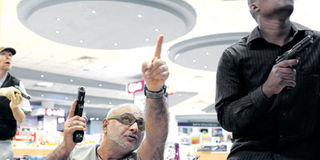Many unanswered questions about Westgate attack

Armed officers inside Westgate. Photo/FILE
What you need to know:
- Mr Lenku maintained the number of terrorists killed stood at five, while 10 suspects had been arrested.
- Officials, who accessed the site Wednesday, said there was a sick odour coming from the building.
- The officers are also using sniffer dogs to check for booby traps or unexploded material.
Hopes of finding survivors following the Westgate mall terror attack faded last evening as the government announced it was getting into the next stage of operation.
The next phase, said Interior Cabinet Secretary Joseph Ole Lenku, will involve forensic process of identifying the dead through their fingerprints and DNA.
There will also be ballistics tests to determine the nature of weapons and ammunition used in the siege, Mr Lenku said during a press conference at the junction of Lower Kabete and Peponi roads, where teams from the US, Israel, Britain, Germany, Canada and Interpol had joined Kenyan policemen for the investigations.
“We’re convinced there would be insignificant, if any, bodies there except for those of the terrorists,” the minister said.
Mr Lenku maintained the number of terrorists killed stood at five, while 10 suspects had been arrested.
“We strongly believe that there is an insignificant number of bodies in the mall,” he said.
The forensics process will take “not less than seven days”, he said, as he asked Kenyans to let the experts answer the many unanswered questions about the attack.
As he spoke, white smoke wafted from the Westgate building, where three floors partially collapsed as the assault on the terrorists by the combined forces progressed.
Military personnel, who were involved in the assault, told the Nation that “the last people to leave this place alive left on Monday”.
A soldier, who cannot be named, said that a blast heard earlier in the morning was that of a gas cylinder exploding.
MANY HOSTAGES
He said that by Sunday morning, when the security forces had taken control of the second floor, “there were many hostages and they were both adults and children”.
Another soldier said the collapse of the floors was caused by the terrorists to finish off any survivors left, although there have been differing accounts of what actually happened.
Officials, who accessed the site Wednesday, said there was a sick odour coming from the building.
An officer at the scene said the next task would involve cutting off the collapsed part of the concrete slab.
This involves cutting through the steel and knocking down the masonry in the beam.
The pieces would then be lifted off to expose the slab beneath to remove any bodies.
Because three floors collapsed, the officer said, the task would take time to accomplish.
The officers are also using sniffer dogs to check for booby traps or unexploded material.
“The current phase is to try and ensure that the building is safe and secure so that the really detailed police work can begin at the crime scene and gather the evidence,” British High Commissioner Christian Turner said after visiting the compound.
“We need to manage expectations,” he said. “This will take some time. We all want answers, we all want to know who is responsible for this brutal, cowardly and unconscionable act, but we now need to let professionals do the job.
“For the Kenyans among you, I think the phrase ‘Haraka haraka haina baraka’ (Hurry, hurry has no blessings)... (would apply).”
Yesterday, chief government pathologist Johansen Oduor, ballistic experts, crime scene and homicide detectives collected samples from the scene to help establish the identity of the attackers and dead hostages, and what might have caused the deaths.
COLLECTED SAMPLES
Some of the samples collected included spent cartridges, burnt body parts, blood samples, clothing and shrapnel from grenades.
The attackers are said to have completely burnt the bodies of their colleagues killed during the combat.
“Some of them were burnt to ashes,” said one of the officers.
Secretary to the Cabinet Francis Kimemia yesterday visited the scene and urged for more time to facilitate comprehensive investigations.
“Forensic analysis has commenced. Let’s give time to the investigators,” he said.
Experts conducted safety measures for the better part of yesterday, amid fears the attackers could have wire-bombed the building.
“Nobody can enter Westgate as of now because terrorists may have wire-bombed some areas and the building could cave in,” Mr Kimemia said.
Reported by JOHN NGIRACHU twitter: @JohnNgirachu [email protected] and ZADOCK ANGIRA twitter: @ZadockAngira
[email protected]




